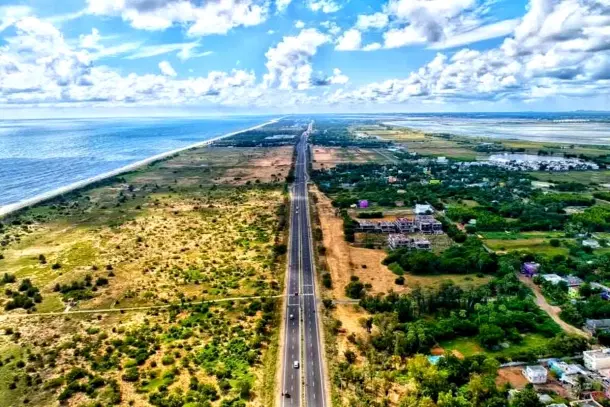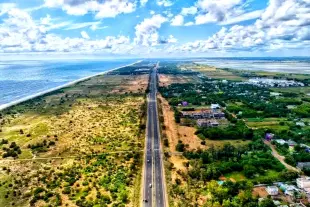Infrastructure
East Coast Road Expansion: Budget For Thiruvanmiyur-Akkarai Stretch Skyrockets To Rs 1,099 Crore, Becomes Tamil Nadu's Costliest Road Project
V Bhagya Subhashini
Aug 16, 2023, 12:26 PM | Updated 12:24 PM IST
Save & read from anywhere!
Bookmark stories for easy access on any device or the Swarajya app.


The expansion of a 10.3-km section of East Coast Road (ECR) from Thiruvamiyur to Akkarai into a six-lane highway has become the costliest road project ever undertaken by the Tamil Nadu state highways department.
The picturesque ECR is an important road corridor in Tamil Nadu connecting Chennai with Cuddalore, through Puducherry. The road was formed in 1998 by interlinking and improving a series of small village roads that were connecting the fishing villages along the coast of Bay of Bengal.
The Thiruvamiyur to Akkarai expansion project's expenses have skyrocketed due to a three-fold increase in land acquisition costs over the span of 10 years.
The state highways department has allocated a budget of Rs 1,099 crore for the project, averaging Rs 106 crore per kilometre of road.
Compared to the average construction cost of Rs 95 crore per kilometre for a four-lane flyover in Koyambedu, the construction costs for three-lane flyovers at Retteri, Pallavaram, and Medavakkam ranged from Rs 45 crore to Rs 48 crore per kilometer.
The cost of acquiring land for the ECR project, initially estimated at Rs 356 crore in 2012, had surged to Rs 756 crore in 2019 and further increased to Rs 940 crore in February this year.
According to highway officials, the actual construction cost of the ECR project, which began in 2022, is Rs 159 crore, accounting for 15 per cent of the total project cost. The project is expected to be completed within the next nine months.
The current width of the four-lane ECR varies from 50 to 80 feet, and the plan is to expand it to 102 feet by adding an additional lane on each side, along with provision for a storm-water drain.
Officials have stated that the road widening is necessary due to heavy traffic congestion in the densely populated residential area.
The increased cost can be attributed to two factors: the issuance of Natham settlement pattas between 2006 and 2009 and the authorisation for constructing multi-storey residential and commercial buildings on the stretch until 2008.
According to The New Indian Express report, the government announced the six-lane project in 2005. However, pattas for grama natham land parcels were issued until 2009 for villages along the ECR that were previously part of Kancheepuram district.
Grama natham lands technically belong to the government but are designated for public habitation, unlike porambokku land which is entirely under the control of the government.
Despite being aware of the ECR widening project, revenue authorities succumbed to the pressures of village panchayat presidents and other local leaders and issued pattas.
These land parcels were subsequently sold to private parties, resulting in an escalation of land acquisition cost, as stated by an official.
In addition to the above factors, government agencies also allowed the construction of multi-storey residential buildings and commercial shops on private lands until 2008. This further contributed to the higher compensation being paid to the landowners.
While dismissing the petitions challenging land acquisition, the Madras High Court upheld the validity of grama natham pattas, considering them equivalent to private pattas. The court also directed that landowners should receive increased compensation.
Unfortunately, the delay in the ECR widening project has caused a setback in the construction of flyovers at the intersection of Lattice Bridge Road and ECR. This delay is particularly affecting the Jayanthi theatre signal in Thiruvanmiyur and the Akkarai junction.
V Bhagya Subhashini is a staff writer at Swarajya. She tracks infrastructure developments.





